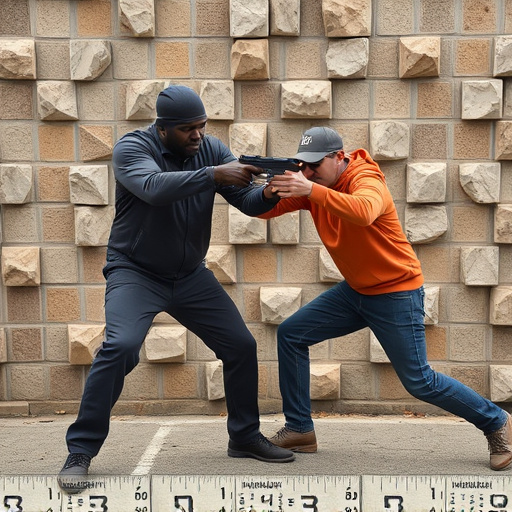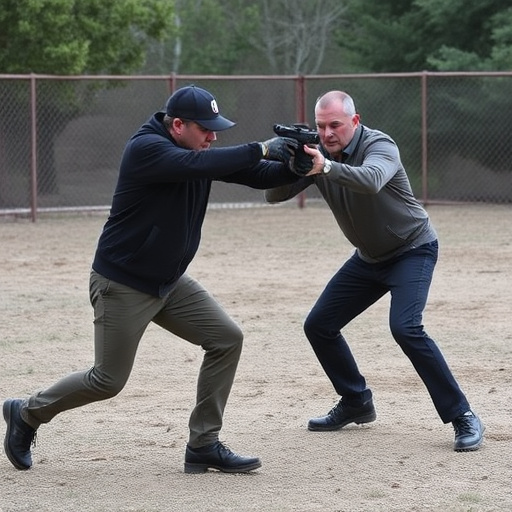Stun guns temporarily disable targets by overloading their nervous system with high-voltage, low-amperage electric pulses, causing muscle spasms and loss of balance. Safety switches require firm pressure to activate, minimizing accidental discharges. Bystanders are generally protected unless in direct contact with the victim during activation.
Discover the critical safety feature of stun guns: the activation switch. This article delves into the intricate mechanisms behind stun gun deployment, specifically focusing on how these devices impact the nervous system. We explore the neurological effects of a stun gun discharge and emphasize the importance of safety measures to protect both users and bystanders. Understanding these aspects is key to ensuring responsible use in self-defense scenarios.
- Understanding Stun Gun Activation Mechanisms
- The Neurological Impact of Stun Gun Discharge
- Safety Measures: Protecting Users and Bystanders
Understanding Stun Gun Activation Mechanisms

Stun guns, also known as electronic control devices (ECDs), operate through a combination of electrical impulses and mechanical design to achieve their de-escalation effects. Understanding how these weapons activate is crucial in gauging their safety mechanisms. The primary action involves a trigger mechanism that initiates an electric current, delivering a powerful shock designed to temporarily incapacitate the target by overloading their nervous system. This disruption in neural communication leads to muscle spasms and loss of balance, allowing users to gain control or escape potentially harmful situations.
The activation switch plays a pivotal role in ensuring user safety. Most stun guns require a firm and deliberate pressure on this switch before the electrical circuit is completed, delivering the shock. This design element serves as a safeguard against accidental discharge, as it prevents the device from firing unless intentionally activated. Such precautions are vital to mitigate risks, especially in situations where the tool might be handled by individuals with varying levels of experience or when dealing with vulnerable populations.
The Neurological Impact of Stun Gun Discharge

When a stun gun is activated, it releases an electric charge designed to disrupt muscle control and cause temporary incapacitation. The primary target of this shock is the nervous system. The stun gun delivers a high-voltage, low-amperage electrical pulse that interferes with the normal transmission of nerve signals in the body. This interruption can lead to significant physiological responses, including loss of balance, muscle spasms, and even respiratory distress.
The effects on the nervous system are rapid and intense. The shock can cause the victim to fall to the ground, rendering them temporarily immobile. This sudden and powerful stimulation can also trigger a ‘fight or flight’ response, leading to increased heart rate and blood pressure. Importantly, while these effects are unpleasant and disorienting, they are not typically life-threatening, and individuals usually recover quickly after the discharge ceases.
Safety Measures: Protecting Users and Bystanders

Stun guns, despite their intimidating nature, are designed with safety as a top priority. One critical feature is the activation safety switch, which significantly reduces the risk of accidental discharge. This mechanism requires intentional and deliberate action to activate the device, ensuring that users control its powerful effects.
The stun gun’s impact on the nervous system is a key aspect of its effectiveness. When deployed, it delivers an electric shock that disrupts neural communication, temporarily paralyzing the target. This disruption does not affect bystanders unless they come into direct contact with the device or are very close to the victim during activation. By requiring explicit user input, the safety switch acts as a safeguard against unintended use, minimizing potential harm to innocent people in the vicinity.
The stun gun, with its powerful activation safety switch, serves as a crucial tool for personal defense. Understanding how these devices work, their impact on the nervous system, and implementing strict safety measures ensures responsible use. By prioritizing user and bystander protection, we can harness the effectiveness of stun guns while mitigating potential risks, making them valuable tools in the right hands.
